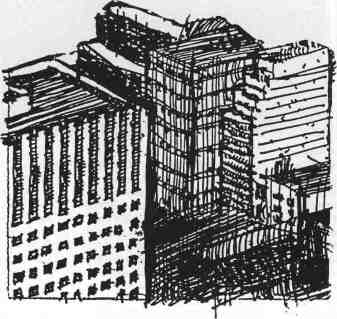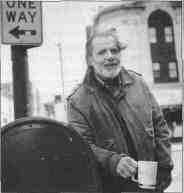Housing the poor
Chicago has a new battle plan.
But can the city win the war?
by Burney Simpson
Illustration by Rails Melotte
Photograph by Nathan Mandell
The front line in Chicago's long-
running struggle to provide shelter for that city's poorest citizens has
moved to the near West Side, specifically to a public housing complex
named for a former Illinois governor.
The 45-year-old Henry Horner
Homes lie in the shadow of the
imposing United Center, where the
Bulls won so many of that team's
championships over the last several
years. It's unlikely the residents of
Henry Horner could afford to attend
any those high-priced playoff games.
Still, they managed
to secure a hard-
fought victory of
their own in the last
decade.
With the help of
their lawyer, William
Wilen, they won a
consent decree from
a federal court that
requires the city to
replace each of the
units in their crumbling mid- and high-
rise buildings.
In 1998, according
to the Chicago
Housing Authority,
1, 897 residents lived
in 1, 570 units at
Henry Horner.
But over the next
few years, seven
mid-rises and four
high-rises that house
low-income people
will be torn down. During the first
reconstruction phase, 380 units of
low-rise and two-apartment town-
homes are going up. Many already are
occupied.
"When we began in 1991, Horner
was gang controlled, and there was
a 49 percent vacancy. The conditions
were deplorable," says Wilen, who
works for the Poverty Law Project in
Chicago. "In nine years, there's been a
remarkable transformation."
In fact, the changes at Horner
represent something more: the latest transformation in city and federal
housing policy.

|
Sixty years ago, policy-makers
considered public housing — built in
subsequent decades mostly on Chicago's West and South sides — a step up
for the city's low-income residents, a
solution to the crowded and unsafe
tenements and shacks that had been
thrown up, block upon block, in
Chicago and other major cities during
the first half of the 20th century.
In the 1930s, those structures were
replaced with low-rise, low-income
public housing. In
the 1940s, similar
housing was built for
returning World War
II veterans.
In the 1950s,
though, high-rise
public buildings
became popular.
They were considered a step up, too.
Planners believed
shared walkways
and parkways would
foster community.
Though tenants
didn't have their own
yards, the large open
spaces surrounding
these buildings were
intended to be used
as recreation areas.
The high-rises had
the advantage, as
well, of concentrating more people into
|
18 / January 2000 Illinois Issues
smaller areas.
But in the 1960s, policy-makers
made a series of shifts in their "war
against poverty" that had disastrous
consequences. With the best of
intentions, federal officials began
to focus assistance programs on
nonworking, single mothers with
children. A similar focus took hold at
the Department of Housing and
Urban Development. The result was
that, over time, public housing filled
up with nonworking tenants.
As working families left, social
pathologies spread. And the high-
rises became havens for crime. They
became, in short, updated versions of
the dangerous tenements and shanties
of an earlier era.
According to The Poorhouse:
Subsidized Housing in Chicago, 1895-
1976 by Devereaux Bowly Jr., at the
end of 1975 there were 131, 513
residents living in 42, 735 public
housing units throughout the city,
including those in senior housing.
Single-parent families lived in 87
percent of those units. Whites had
moved out, too, leaving public
housing racially segregated. Fully 95
percent of the residents of Chicago's
public family housing were black by
the mid-70s.
In the two decades after the
publication of Bowly's book, the
problems in Chicago's public housing
only got worse.
So bad, in fact, that the federal
government took control of the city's
program in 1995, citing a long record
of mismanagement of a deteriorating
housing stock.
Chicago wasn't alone. Housing
authorities throughout the nation
came under federal scrutiny. HUD
has taken over eight housing authorities since 1985, including those in
East St. Louis and Springfield.
Willis H. Logan, executive
director of the reconstituted
Springfield Housing Authority,
argues federal policies were due
for an overhaul.
The federal agency returned
|
Declining sympathy for those who have no homes
What happened to the homeless?
Are there fewer of them than a
decade ago? It would appear so, but
appearances can be deceiving.
Advocates for the homeless and
public officials disagree about
whether homelessness is increasing
or declining. But no one disputes the
notion that tens of thousands of
Illinoisans live on the streets.
An estimated 41, 000 people stayed
in shelters in the six-county metropolitan Chicago area during the past year.
Another 40, 000 to 60, 000 people are
thought to have spent the night on the
street at least once in that period,
according to a November report on
housing commissioned by the Metropolitan Planning Council. Another
32, 000 to 65, 000 families had to share
quarters with another family.
Nevertheless, the homeless are undercounted, advocates maintain, because
the fastest growing population among
the homeless is comprised of families
with children. "Nationally, the average
age of a homeless person is 9, and
we see that here as well," says John
Donahue, executive director of the
Chicago Coalition for the Homeless.
The coalition estimates that families
with children account for 45 percent of
Chicago's homeless population.
The future doesn't look promising.
Rent increases outpaced inflation in
the 1990s. In 1999, about 38 percent of
the region's renters had to use more
than 30 percent of their income for
rent. The average cost of a two-
bedroon rental in the region is $723.
The federal government's latest
panacea — housing vouchers — also
falls short of solving the problem.
Federally funded Section 8 subsidies
are designed to make it possible for
low-income families to move into
approved private-market housing.
Some 41, 000 metropolitan area families received Section 8 subsidies last
year, according to the Metropolitan
Planning Council's report. But
another 60, 000 households were on a
waiting list for the vouchers. In the city
of Chicago, 25, 452 low-income people
had received the vouchers as of
December 1. Another 30, 000 were on
a waiting list.
Even those who secure Section 8
housing may have difficulty finding a
place to live. Because of the tight
rental market, landlords can afford to
be selective. Tenants in Section 8
homes reported facing discrimination
and additional hurdles.
Donahue sees a decline in sympathy for the homeless. They are out of
sight, he says, but they're not gone.
The Editors
|

Why Illinoisans live on the streets
• Chicago lost 400, 000 manufacturing
jobs between 1971 and 1999.
• A family of four in Chicago needs an
annual income of $33, 775 to pay for
basic needs.
• In 1998, the buying power of a welfare
grant for a family of three had declined
to 44 percent of the buying power of a
grant in 1973.
• In Illinois, there are four unemployed,
low-skilled workers for every available
entry-level job.
• The number of low-income renters out-
paces the number of affordable housing
units by about 130, 000 people.
Source: Chicago Coalition for the Homeless
|
Illinois Issues January 2000 / 19

Congress ordered local
housing officials to
tear down older
developments if they
were too costly to rehab.
Springfield's housing authority
to local control in 1997. Since
coming on board as part of that
reorganization, Logan has overseen
demolition of the capital city's major
public housing complex, the
crumbling John Hay Homes.
Indeed, a fed up Congress ordered
local housing officials everywhere to
tear down older developments if they
were too costly to rehab. Though
housing activists agree public developments throughout the country had
fallen into a sorry state, they worry
that displaced residents won't be able
to secure other affordable homes.
Logan is upbeat, though. And
a relentless promoter. He has
developed ads that tout the good
qualities of low-income renters.
And he argues national policies now
give those renters a greater feeling
of ownership, that the change has
paid off.
"The federal government finally
realized that people appreciate it
more if they have an ownership stake.
They take better care of the property
and themselves."
Meanwhile, Chicago's housing
authority was returned to local
control last spring. If for no other
reason, the size of that city's low-
income population makes the
problems there more complex. In
1998, the Chicago authority was
responsible for 46, 726 residents in
26, 496 units located in 17 low- and
high-rise developments.
For starters, the feds called on the
city to privatize management of its
Section 8 program, which offers
subsidies to low-income residents for
market-rate housing.
And the city has a new plan to tear
down the crime-ridden high-rises and
build neighborhoods of mixed
income housing. Those new homes
will be modest, but they'll have
small private yards. And Chicago
officials believe that will foster pride,
encourage cleaner streets and
discourage graffiti and crime.
And they believe that putting
working families back into public
housing will provide stability.
"The residents of the CHA are not
getting a fair shake. Those buildings
and those neighborhoods are not up
to par," argues Rod Sierra, Chicago
Mayor Richard Daley's press aide.
"[Mayor Daley] adamantly wants to
take control and get these fixed once
and for all."
To that end, Daley named Phillip
Jackson as the new chief executive
officer in June. Jackson grew up in
Chicago public housing and most
recently had been chief of staff for
the city's Board of Education during
Daley's efforts to reform the schools.
He has wasted no time. By September, Jackson had announced plans for
a $1.5 billion capital program to build
or rehab 24, 000 units where the
authority's buildings now stand. The
construction will take five to six years
and residents in good standing will be
guaranteed a home, even if they must
move out during construction.
By next summer, the authority
plans to hire professional management firms to oversee all properties,
and cut its own staff of 1, 300. The
savings will go into housing. And
$20 million of the construction
dollars will be used for an apprenticeship program for residents, leading to
a projected 3, 000 jobs.
Jackson also has asked HUD to
waive or limit 38 federal housing rules
so the authority will have more
leeway in demolitions and in setting
eligibility for replacement tenants.
Jackson argues that having the full
support of the mayor will make the
difference because other city agencies
— previously standoffish — will be
brought on board. For example, last
fall the authority's police force was
disbanded, and the Chicago Police
Department will now oversee the
developments. The authority board is
expected to review the plans this
month. If approved, they will go to
HUD for review.
These are hopeful signs. Not that
there haven't been problems. There
has been some damage in the new
Horner Homes. And crime has
followed the residents as they moved.
But adjustments are inevitable,
argues Sue Sago, a 17-year Horner
resident who moved into replacement
housing. It shouldn't surprise anyone,
she says, that children used to playing
in cinder block apartments will likely
damage the plasterboard walls of
their new homes.
"You need to give low-income people
time to acquire the tools they need."
There is still tension between some
neighborhood residents and the
Horner transplants. While much of
the replacement housing is on the land
where the high-rises once stood, some
of it has been built next to market-
rate housing on nearby streets. And
the two-flats are designed to house a
public housing tenant and a market-rate renter. That can turn out to be a
learning experience for both.
Wilen, who continues to negotiate
for more units, also is working on
screening requirements for those
tenants applying to move into the
neighborhood. But he notes the tenor
of the discussions has changed.
The attitude, he says, used to be
"demolish, demolish, demolish. Now
it's build, build, build."
Horner resident Sago takes the
long view. She acknowledges
residents were as much to blame for
the disrepair and disrepute of public
housing as the authority.
"The CHA failed the residents and
the residents failed themselves," says
Sago. Now, she says, "everybody has
to do better. I came as a temporary.
Sometimes you have to stay and
fight." ž
20 / January 2000 Illinois Issues
This page is created by
Sam S. Manivong, Illinois Periodicals Online Coordinator
Illinois Periodicals Online (IPO) is a digital imaging project at the
Northern Illinois University Libraries funded by the Illinois State Library
|


